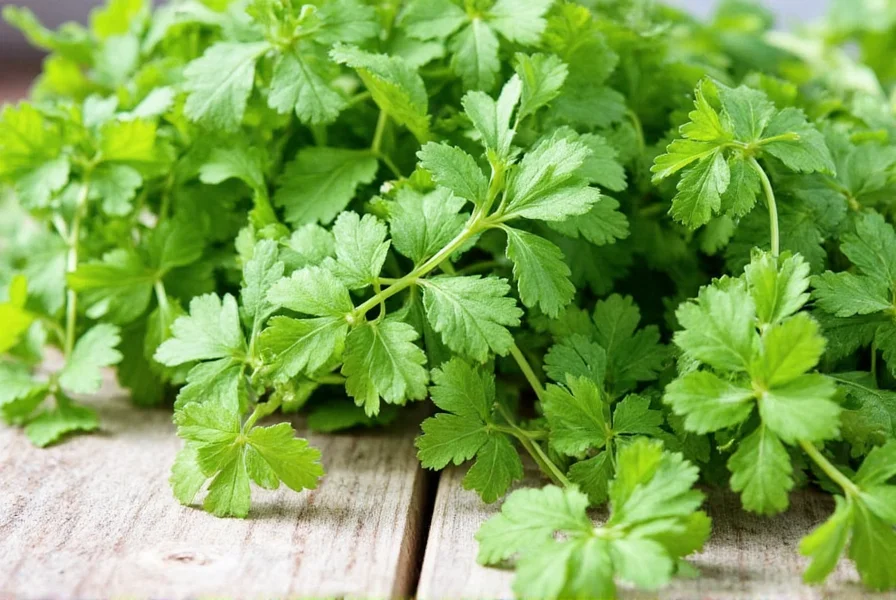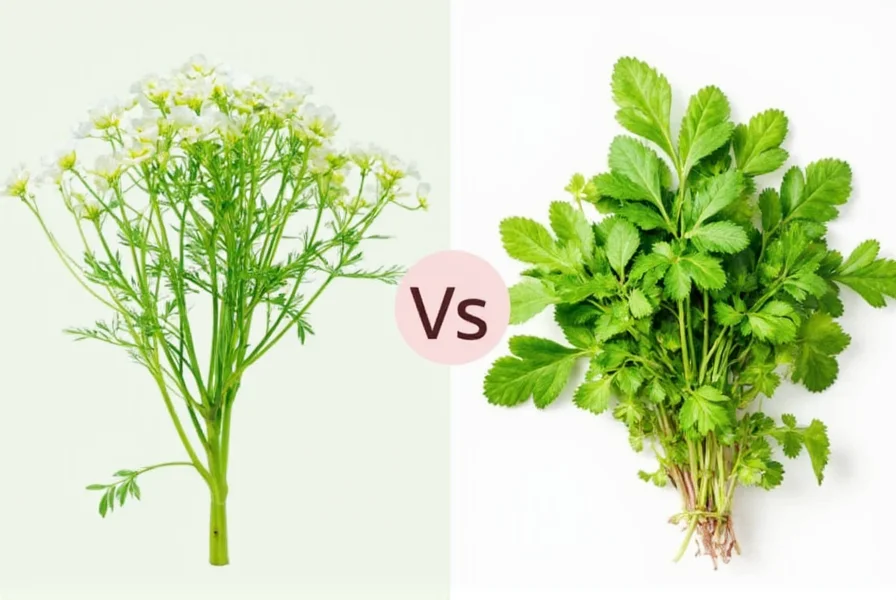Yes, coriander and cilantro come from the exact same plant—Coriandrum sativum. The naming difference stems entirely from regional language preferences, not botanical distinctions. In the United States and Canada, the fresh leaves are called "cilantro" while the seeds are "coriander." Most other English-speaking countries, including the UK, Australia, and India, refer to both the leaves and seeds as "coriander."
Understanding the coriander-cilantro relationship resolves a common culinary confusion that trips up home cooks and professional chefs alike. This aromatic herb belongs to the Apiaceae family, sharing botanical roots with parsley, carrots, and celery. The plant produces delicate, lacy green leaves prized for fresh applications, along with spherical seeds that develop after flowering. Both components offer distinct flavor profiles despite originating from the same source.
Botanically speaking, Coriandrum sativum doesn't recognize the linguistic divide between "coriander" and "cilantro." These terms represent regional naming conventions rather than different plants or even different varieties. The confusion arises because English speakers worldwide adopted different parts of the plant's historical naming tradition.

The Linguistic Origins of Coriander vs Cilantro
The word "coriander" traces back through French and Latin to the Greek "koris," meaning bedbug—referencing the plant's distinctive scent that some compare to crushed insects. Spanish speakers adapted this as "cilantro," which entered American English through Mexican culinary influence. When Spanish colonists brought the plant to the Americas, they used "cilantro" specifically for the leaves, while retaining "coriandro" for the seeds.
This linguistic split created the modern naming convention where Americans distinguish between cilantro (leaves) and coriander (seeds), while most other English speakers use "coriander" for both. The International Herb Association officially recognizes "coriander" as the standard English term for the entire plant.
Regional Terminology Differences Explained
| Region | Leaves Called | Seeds Called | Common Usage Context |
|---|---|---|---|
| United States & Canada | Cilantro | Coriander | Recipe ingredients, grocery labels |
| United Kingdom & Ireland | Coriander (leaves) | Coriander (seeds) | Cookbooks, supermarkets |
| Australia & New Zealand | Coriander | Coriander seeds | Menus, cooking shows |
| India & South Asia | Dhaniya (leaves) | Dhaniya (seeds) | Regional languages, spice markets |
| Mexico & Latin America | Cilantro | Coriandro | Culinary contexts, markets |
Botanical Reality: One Plant, Multiple Components
The complete Coriandrum sativum plant offers several culinary components:
- Fresh leaves (called cilantro in the Americas): Bright, citrusy flavor with soapy notes for some due to genetic factors
- Stems: Often used in cooking for concentrated flavor
- Seeds (called coriander worldwide): Warm, nutty, citrus-tinged spice used whole or ground
- Roots: Prized in Southeast Asian cuisine for intense flavor
- Flowers: Edible with mild coriander flavor
When recipes specify "coriander" in American contexts, they typically mean the dried seeds. Outside North America, "coriander" could refer to either the fresh leaves or the seeds, requiring cooks to interpret based on context. This explains why many international recipes cause confusion for American cooks unfamiliar with the terminology differences.
Culinary Implications of the Naming Confusion
The terminology divide creates practical challenges in recipe interpretation. An American chef following a British recipe saying "add chopped coriander" might mistakenly use coriander seeds rather than fresh leaves. Conversely, a UK cook attempting an American recipe calling for "cilantro" might struggle to find it labeled that way in British supermarkets.
Professional kitchens often clarify by specifying:
- "Fresh coriander" = leaves (outside North America)
- "Coriander seeds" = dried seeds
- "Cilantro" = leaves (in North America)
When substituting between fresh and dried forms, remember they're not interchangeable 1:1. One tablespoon of fresh cilantro doesn't equal one tablespoon of coriander seeds—their flavor concentrations differ significantly. As a general rule, 1 teaspoon of ground coriander equals approximately 2 tablespoons of fresh cilantro in flavor impact.
Genetic Factors in Flavor Perception
Interestingly, genetic variations affect how people perceive cilantro's flavor. Approximately 21% of East Asians, 17% of Europeans, and 14% of people of African descent possess a genetic variant that makes cilantro taste soapy due to altered olfactory receptor genes. This explains why some people passionately dislike cilantro while others enjoy its bright citrus notes. The same genetic factors don't affect perception of coriander seeds, which have a completely different flavor profile.
Practical Shopping and Cooking Tips
When navigating the coriander-cilantro terminology in real-world situations:
- In American grocery stores, look for "cilantro" in the fresh herb section and "coriander" in the spice aisle
- When shopping internationally, request "fresh coriander" for the leaves
- Substitute dried coriander seeds for fresh cilantro only in cooked dishes where the flavor can mellow
- Freeze fresh cilantro in oil to preserve its flavor longer than refrigeration allows
- Toast coriander seeds before grinding to enhance their aromatic compounds
Understanding that coriander and cilantro represent the same plant with regional naming differences transforms how cooks approach global recipes. This knowledge prevents recipe failures caused by ingredient confusion and opens doors to exploring international cuisines with greater confidence. Whether you call it coriander or cilantro, recognizing it as Coriandrum sativum provides the botanical clarity needed for successful culinary experimentation.
Frequently Asked Questions
Can I substitute coriander seeds for fresh cilantro in recipes?
Not directly—they have completely different flavor profiles. Coriander seeds offer warm, citrusy notes while fresh cilantro provides bright, grassy flavors. In cooked dishes, you might use 1/4 teaspoon ground coriander to approximate 2 tablespoons fresh cilantro, but they're not perfect substitutes. For raw applications like salsas, no seed substitute works adequately.
Why does cilantro taste like soap to some people?
This soapy taste perception comes from genetic variations in olfactory receptor genes, particularly OR6A2. Approximately 1 in 4 people possess this genetic variant that causes certain aldehydes in cilantro to register as soap-like. The phenomenon doesn't affect perception of coriander seeds, which contain different compounds.
Is there any nutritional difference between coriander leaves and seeds?
Yes, significant differences exist. Fresh cilantro (leaves) provides more vitamin K and vitamin A, while coriander seeds contain higher concentrations of dietary fiber, iron, and magnesium. Both offer antioxidants, but different types—leaves contain quercetin while seeds feature linalool. The fresh leaves have minimal calories (23 per 100g) compared to seeds (298 per 100g).
How can I grow coriander/cilantro at home successfully?
Plant coriander seeds directly in well-draining soil as they dislike transplanting. Choose a location with partial sun, especially in warmer climates. Harvest leaves when plants reach 6 inches tall, cutting outer leaves first. For continuous harvest, plant new seeds every 2-3 weeks as the plant bolts quickly in heat. Grow indoors near a sunny window for year-round fresh cilantro.
Why do some recipes specify 'coriander' when they mean the seeds?
This reflects regional terminology differences. In most English-speaking countries outside North America, 'coriander' refers to both the fresh leaves and dried seeds, with context determining which part is meant. American recipes specify 'coriander' for seeds to distinguish from 'cilantro' (leaves). When encountering 'coriander' in international recipes, check whether fresh or dried ingredients are expected based on the dish type.











 浙公网安备
33010002000092号
浙公网安备
33010002000092号 浙B2-20120091-4
浙B2-20120091-4